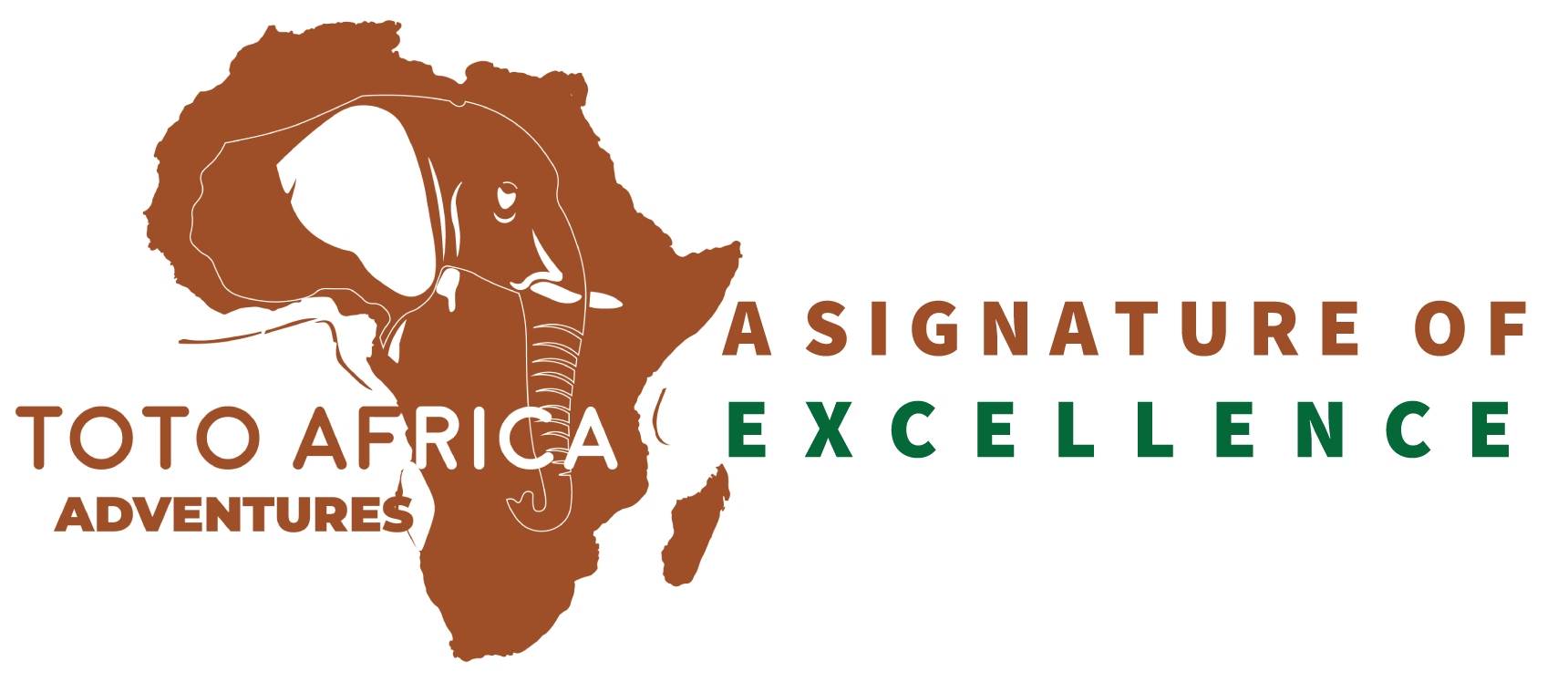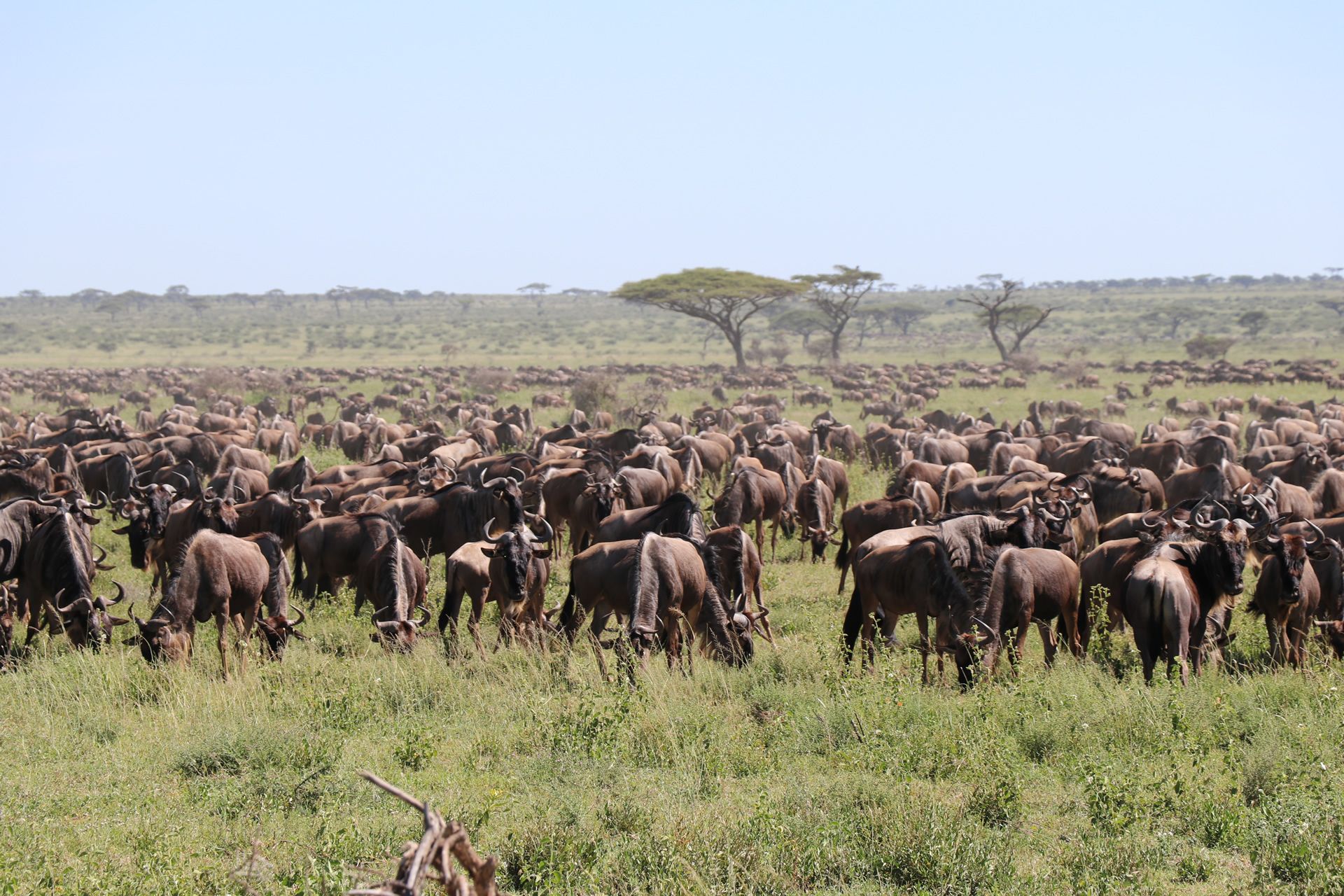The Great Serengeti wildebeest migration
The Great Migration is the largest herd movement of animals on the planet. In fact, with up to 1,000 animals per km², the great columns of wildebeest can be seen from space.
The numbers are astonishing: over 1.2 million wildebeest and 300,000 zebra along with topi and other gazelle move in a constant cycle through the Serengeti-Mara ecosystem in search of nutritious grass and water. Guided by survival instinct, each wildebeest will cover 800 to 1,000km on its individual journey along age-old migration routes. Hungry predators including lion, leopard, cheetah, hyena, wild dog and crocs make sure only the strongest survive in this natural spectacle also known as ‘the greatest show on Earth.’
The circuit takes the animals from the Ngorongoro Conservation Area (although not into the Crater itself) in the south of the Serengeti in Tanzania, up through the Serengeti and across into the Masai Mara in Kenya and back again. The journey is beset with danger: young calves are snatched by predators, the slow are brought down by prides of lion, brave beasts break legs on steep river slopes, crocodiles take their share of the stragglers, and the weak and exhausted drown.

Let us plan your African trip
Start planning your tailor-made trip by contacting one of our Tanzania specialists
The Great Wildebeest Migration: A Closer Look
When planning your Serengeti safari, witnessing the Great Wildebeest Migration is often a top priority. However, ensuring you’re there at the right time can be challenging. The reality is, you can’t guarantee being in the midst of it all. It’s crucial to understand that timing your visit to the Serengeti involves a degree of uncertainty. While we’ve outlined the typical patterns of the Great Migration below, it’s essential to remember that nature operates on its own schedule, and there are no absolutes.
PLAN YOUR SERENGETI MIGRATION SAFARI TODAY
Toto Africa Adventures organizes each luxury safari based on individual interest, with special attention given to the occasion- such as a honeymoon or family reunion. Our staff go the extra mile to communicate with lodges and safari drivers before and during safaris to ensure the best possible experience for our clients.
BEST TIME TO VISIT TANZANIA FOR SERENGETI MIGRATION SAFARI
The best time to visit Tanzania for a Serengeti migration safari is during the dry season from late June to October. This period offers prime viewing of millions of migrating wildebeest and zebras, including dramatic river crossings. The weather is typically dry and sunny, perfect for wildlife spotting. For those keen on seeing newborn animals, January to March during the calving season is also a great option, though herd movements may be less predictable. Ultimately, the best time depends on personal preferences and desired experiences.
Jan
Feb
Mar
April
May
Jun
Jul
Aug
Sep
Oct
Nov
Dec
- It's the calving season,Predators are abundant, taking advantage of vulnerable newborns. The herds are in the southern Serengeti and Ngorongoro Conservation Area (NCA) during this period.
- The herds start to move northwestward, following the rainfall and fresh grass. They begin the journey towards the Western Corridor of the Serengeti, crossing the Grumeti River.
- The herds move further north, reaching the northern Serengeti and crossing the Mara River. This period is characterized by dramatic river crossings and high predator activity.
- The migration continues in the northern Serengeti and spills over into Kenya's Maasai Mara. It's a great time for safaris in both the Serengeti and Maasai Mara, with plenty of wildlife action.
- The herds start their journey back south towards the Serengeti's southern plains, following the rains. This period marks the start of the short rains in the Serengeti.
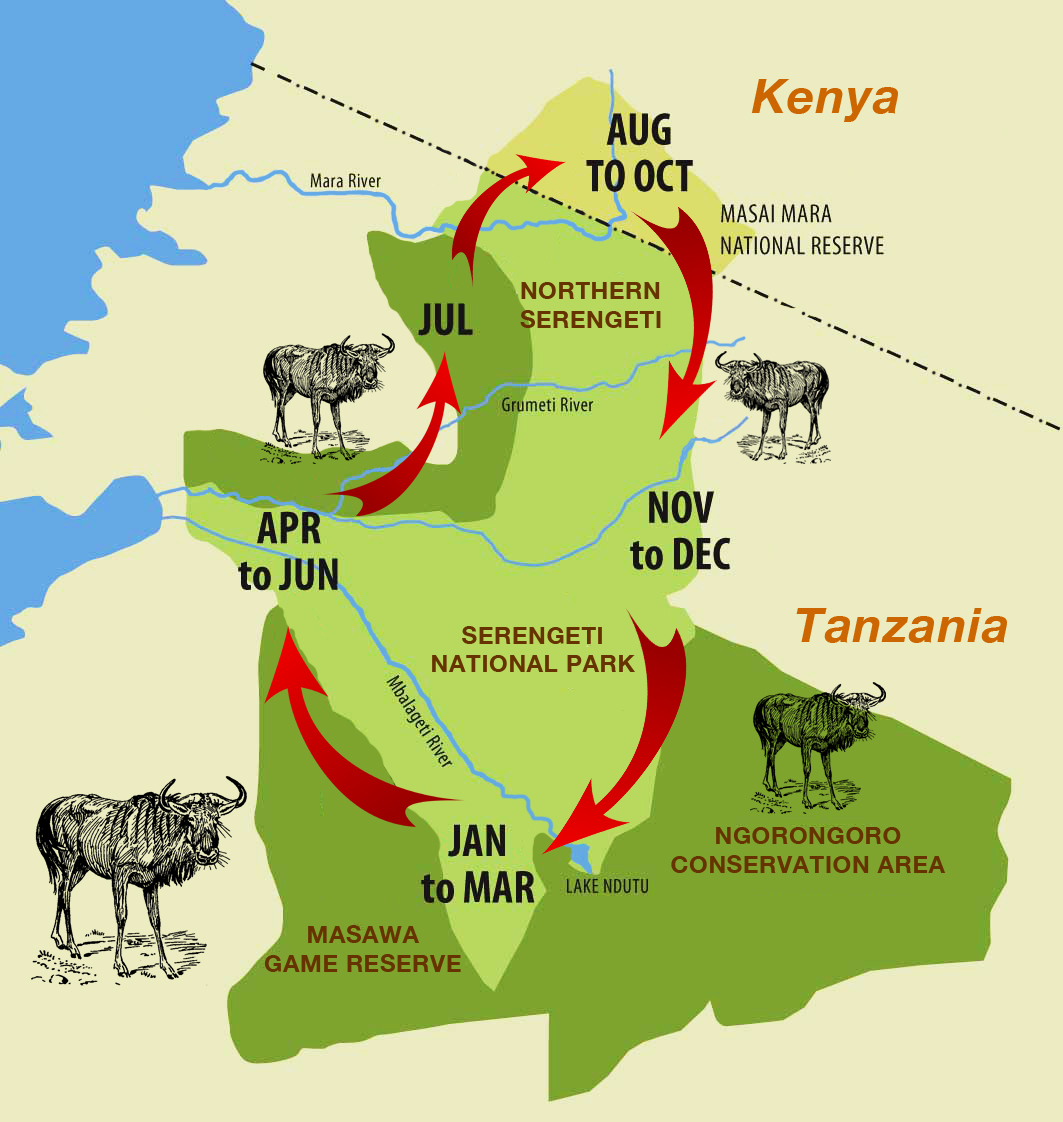

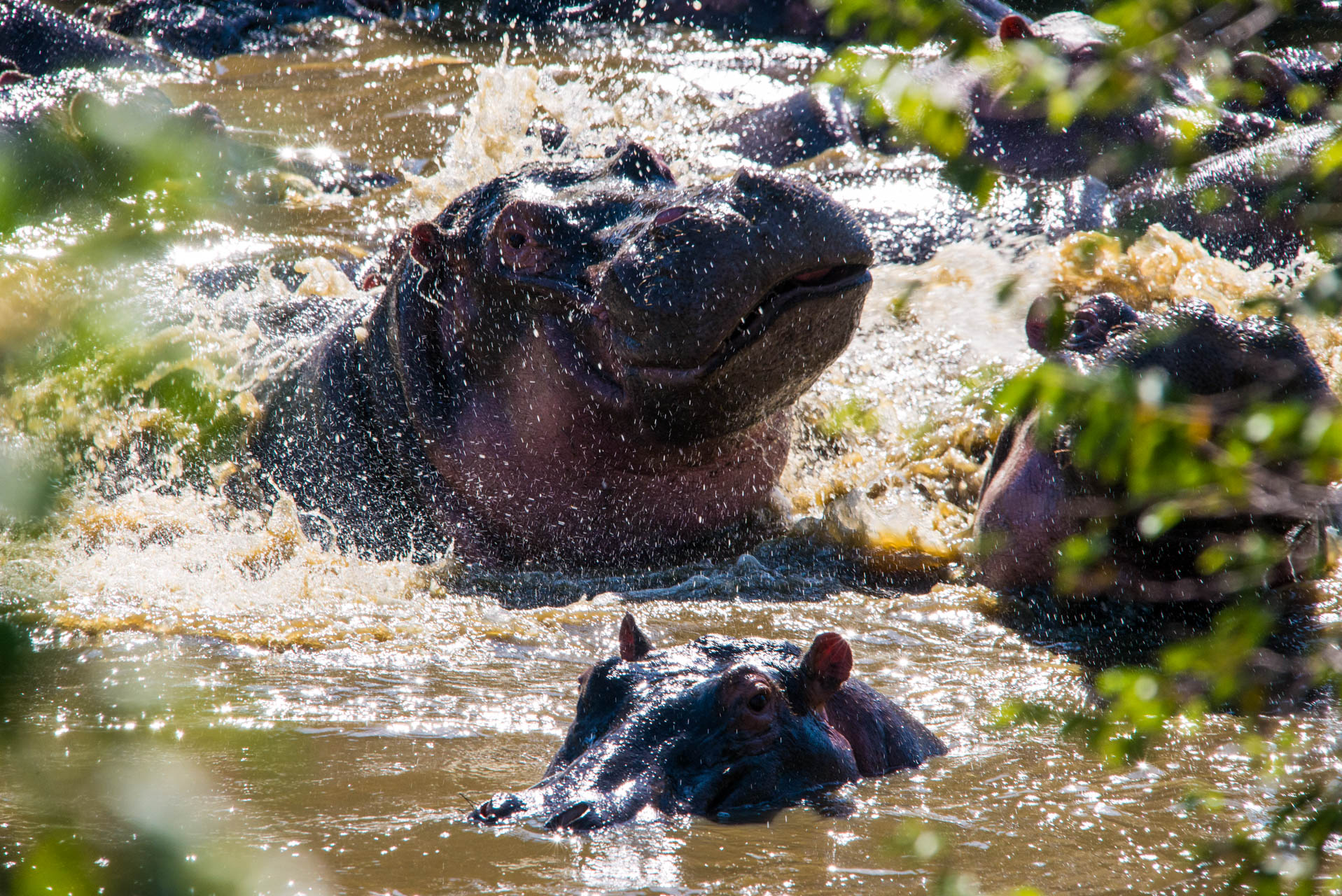
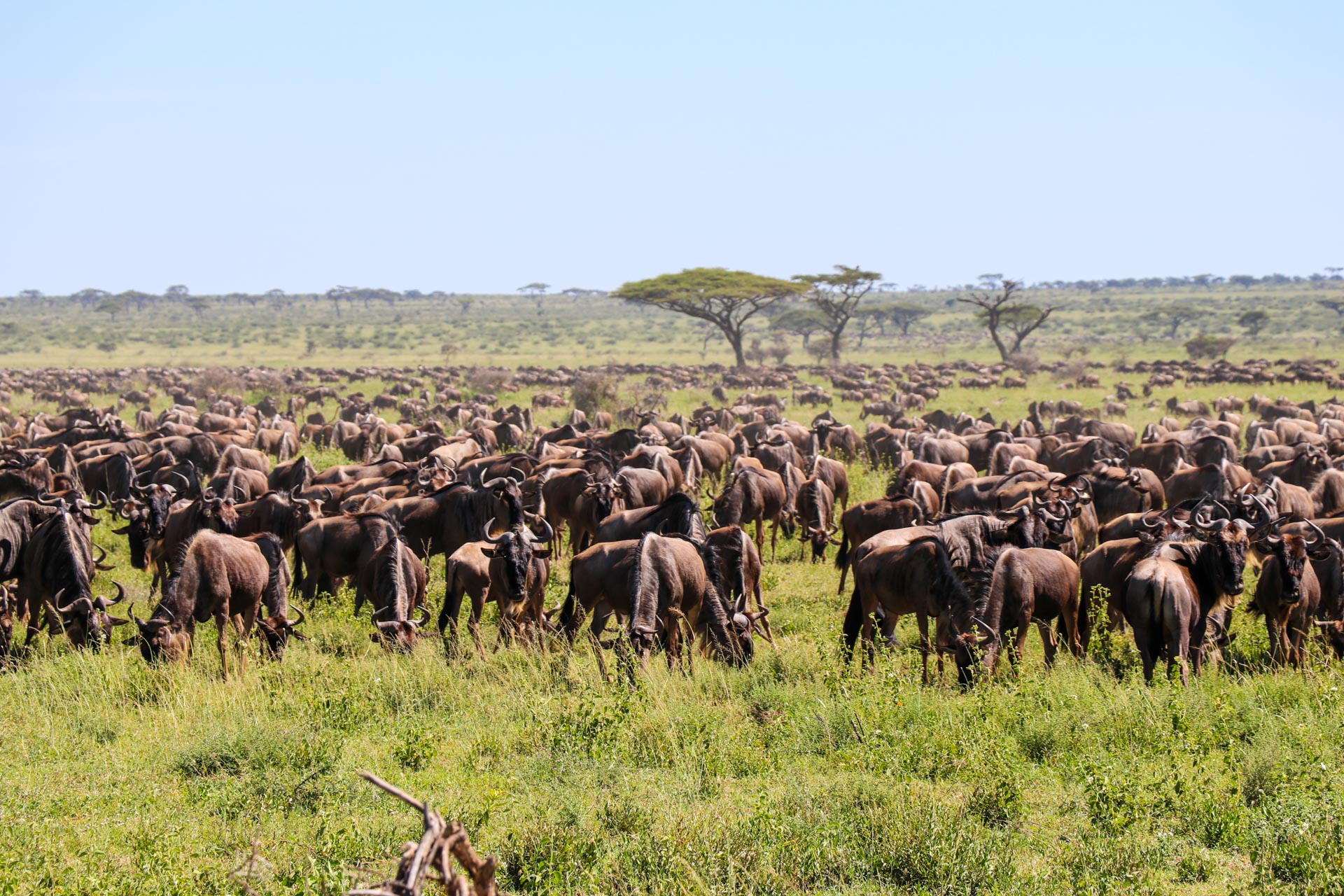
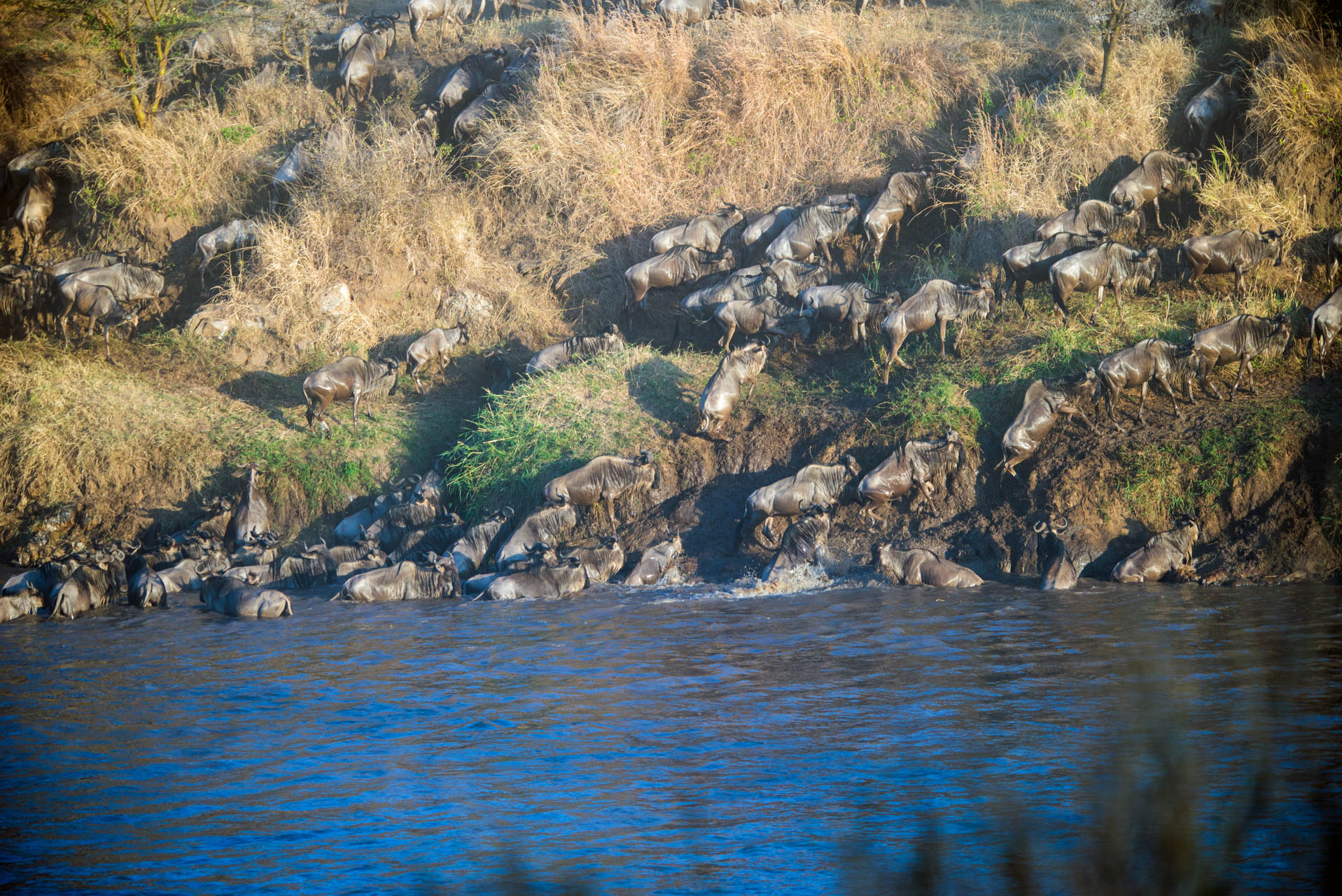
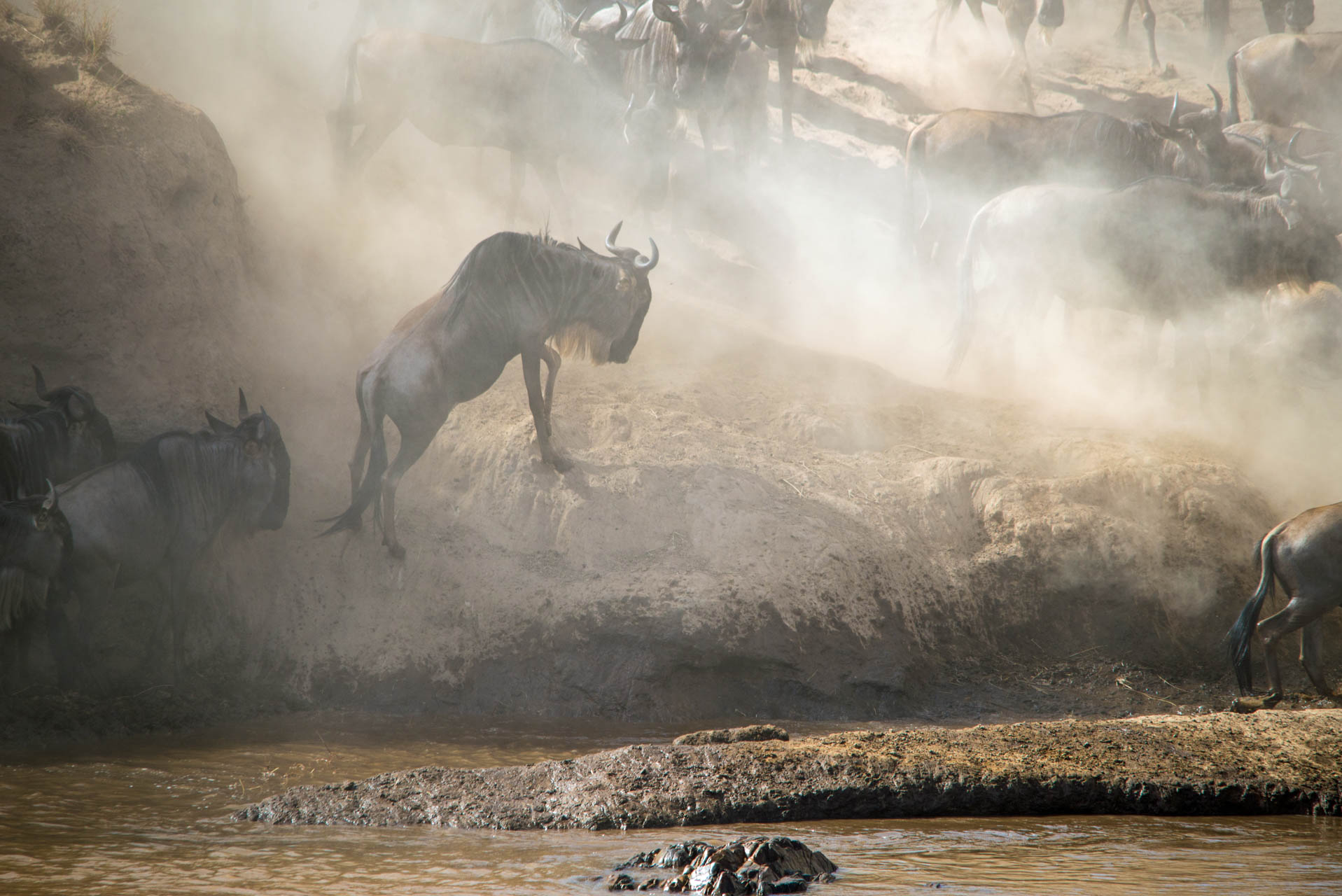
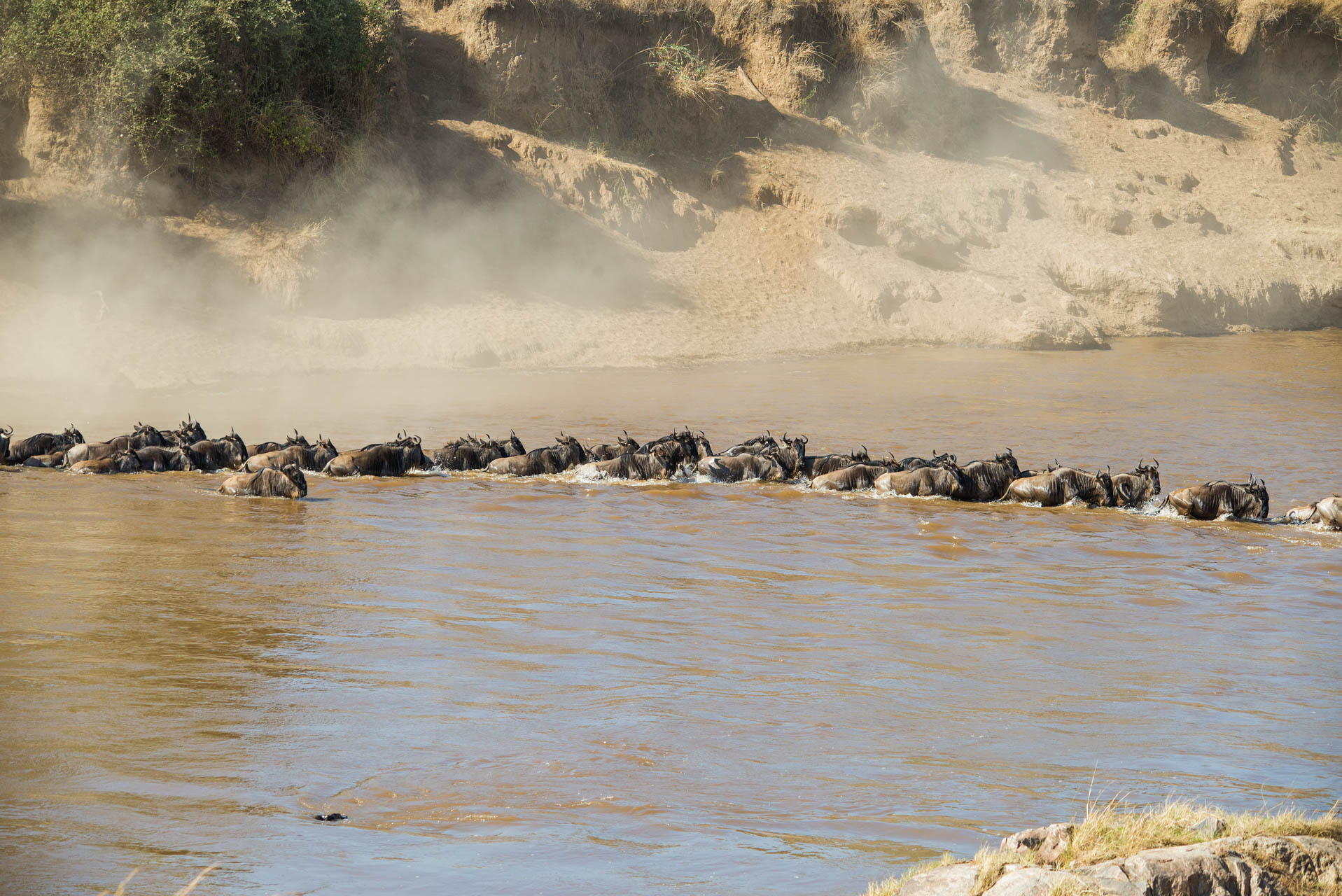
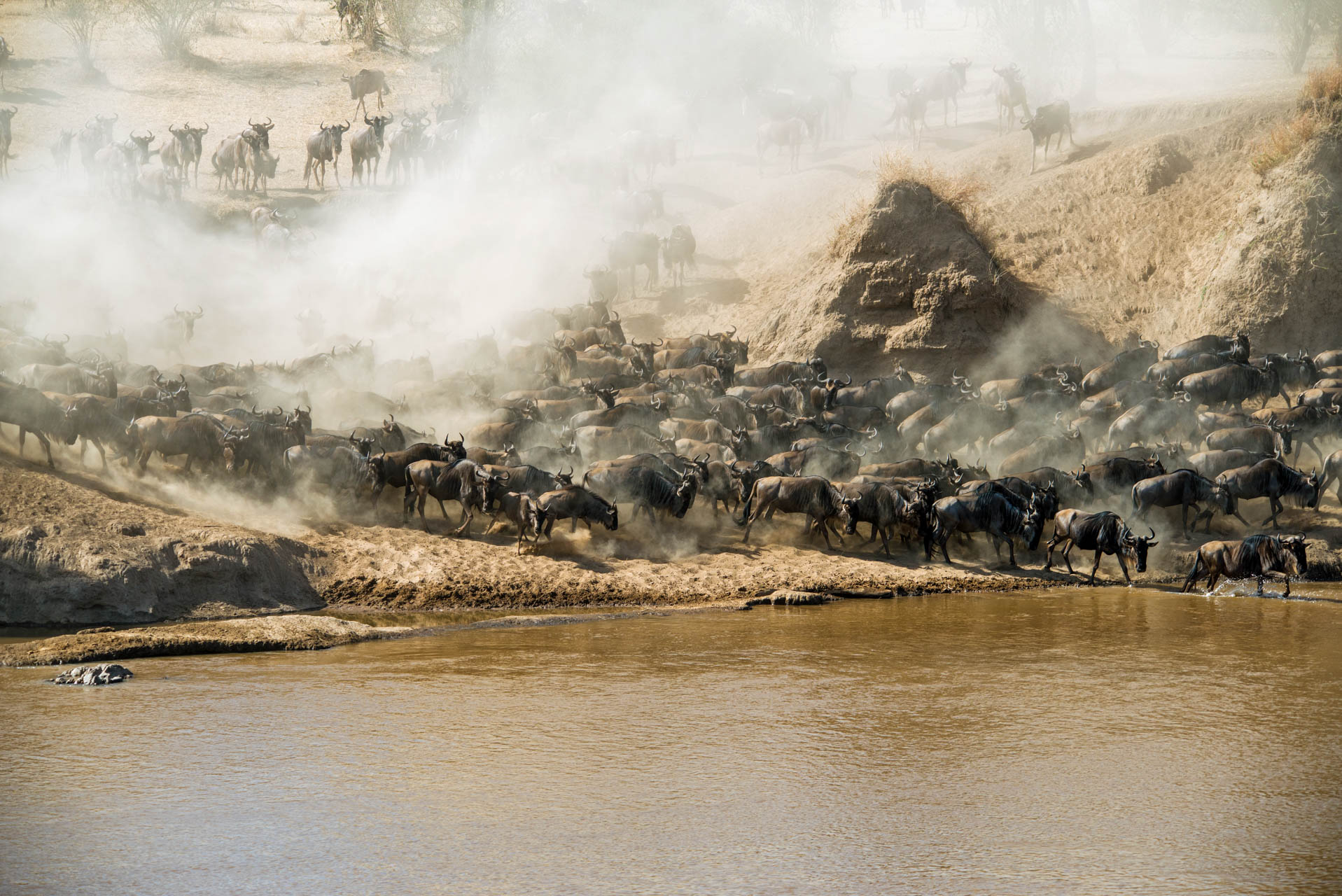
Serengeti Migration Safari Holiday Tours and Travel Packages
Explore our Serengeti Migration Safari Holiday Itineraries. Our expertly crafted tours offer an immersive experience, allowing you to witness thrilling river crossings, encounter diverse wildlife up close, and explore the stunning landscapes of Tanzania. These itineraries are simply suggestions, they’re just for inspiration, worry out if you have your own idea and preferences kindly don’t hesitate to contact us since your trip will be created around your particular tastes.
FAQ's about the Great Serengeti Migration Safari
The Great Wildebeest Migration is the largest animal migration in the world. Every year, more than 2 million animals (wildebeest, zebra, and gazelle) migrate in a clockwise direction across the ecosystems of the Serengeti (Tanzania) and the Masai Mara (Kenya). On the way, they have to cross crocodile-infested rivers, are hunted by predators, and face natural disasters such as droughts and flooding in a daily struggle for survival.
The Great Migration can be enjoyed year round. The first few months of the year offer exceptional predator encounters in Tanzania’s Serengeti as this is the calving season for the wildebeest and newborns make for easier targets. By July, the herds are heading north into the central Serengeti where the wildebeest make their first river crossing, and take their chances against the waiting crocodiles. In August, the herds cross over into Kenya’s Masai Mara and towards the end of the year the herds move southwards back into the Serengeti where the animals brace themselves for the next calving season and predator attacks.
The new & fresh migration safari packages are now available and are organised according to budget and travel dates. They range from between $1650 and $2900. Just remember that you can create your own safari package based on the budget by subtracting a few days and choosing less expensive accommodations. Consider going out of season to keep the price of your package down. But remember that the fall & rise in rates depends on the increase and decrease in demand & thus, it is advised to plan and book your trips and packages wisely to avoid any last minute changes. Certainly, nobody will like to overlook Africa’s Great Serengeti Wildebeest Migration that is one of the top attractions for any safari trip or tour.
It depends on the time of year people visit it. Some people prefer to go during the calving season starting from February till the end of March & others visit the Serengeti Park during the river-crossing season at the Grumeti River from June to mid-July and the Mara River from August till the last day of October. For instance, if there are more accommodations than more people will come to watch the migration and in a similar manner, fewer accommodations means less number of people will come.
Where day-trippers are going in the Maasai Mara is extremely essential. Just speaking with the booking agent will help you in getting the best possible lodgings options in the Mara that would have discoverers to stay in the right quiet little corner.
Yes, it is possible. There are certain key & tactical areas where the herds will pass because of usual migration routes and also because these giant herds need access to drinking water. It means that the tour guides can predict quite exactly where the herds will be situated particularly when they are not mobile during the calving season. Each of these areas has diverse levels of housing & lodgings and the more customers speak with our travel experts, the more options you will get.
Absolutely yes, you can take a scenic flight by hot-air balloon to see migratory herds from above. It is always advised to book in advance, which we will be great for you and once you have your travel dates, you can fly into the air to make your dream come true. There are times of the year where the hot air balloons will be closer to where the migration is. It is also recommended to go for balloon safari in the Mara from August to the end of September, the central Serengeti in June and again during December and January. The western Serengeti corridor can be enjoyed from a hot air balloon during late June and July when spotting and tracking the herds from above will be very easy.
It is suggested to book at least 8 to 12 months in advance. There are a limited number of lodges, so as soon as you start planning the more packages & housing options will be available for the customer at an affordable cost. Thus, making the right moves at right time will help each and every safari enthusiast to witness the greatest wildlife event of all times.
Don't take our word for it— let their testimonials be your guide
We have been receiving reviews from our served clients and Toto Africa Adventures is rated 5/5 by customers. This honor is given to us by customers because we always remain committed to all our customers to do whatever is needed by them to make their safari fully satisfied.
EXCELLENTVerified The Ultimate Luxury Family Travel Experience: Secure, Adaptable, Flexible, Affordable, with Helpful Staff and Beautiful Accommod We recently returned from a 10-day Luxury family safari with Toto Africa Adventures, and we had an amazing time. While organizing our vacation, we looked at several safari operators; in the end, when we contacted Toto Africa in our first correspondence with Chris Japheth, we were impressed by his promptness and adaptability in creating a personalized safari itinerary we decided on Toto Africa Adventures because they provided the best itinerary accommodations for our Family requirements and were the most professional and attentive. Our safari was made extremely enjoyable, safe, and enlightening by our driver guide, Benard. He made an effort to find out what we were most interested in seeing at the start of the trip, and we were able to see a lot more than that. He has an extensive understanding of Tanzania's ecosystems as well as its animal and wildlife populations. He provided comprehensive answers to all of our inquiries and offered insightful commentary on Tanzanian culture and daily life. He made us laugh every day, drove very safely and skillfully, and was always polite. We visited Tarangire Park which is a beautiful park filled with Baobabs and Acacias with a large variety of game such as zebras, buffalo, giraffes, and waterbuck. Of note during this time are the massed elephants along the Tarangire River a tremendous sight and the healthy pride of lions. From there, we head to the Ngorongoro. This is the largest intact crater in the world abundant with wild game including elephants, rhinos, cheetahs, lions, leopards, and hyenas. we also visit the Serengeti, Tanzania’s most famous and largest national park and one of the most spectacular parks in the world. And we spend 4 days in Zanzibar with Toto Africa Adventures. Our chef Alli always prepares super tasty, fresh, and delicious meals every day. They brought various kinds of meals including meat, vegetables, fish, and fruits. We also had special dietary requirements that were met without a problem. We thank the Toto Africa Adventures team for the wonderful 10-day Luxury family safari. Without a doubt, we will tell our friends about Toto Africa Adventures in the future.Verified Amazing family safari in Tanzania. Miss Neema and Guide Mr. Ben of Toto Africa Adventures truly exceeded our expectations! Their personalized service and expertise made our journey through Tanzania unforgettable. Miss Neema's attention to detail ensured every aspect of our trip was seamless, while Guide Mr. Ben's extensive knowledge of the region's wildlife and culture enriched our experience beyond measure. Together, they created an atmosphere of warmth and hospitality that made us feel like family. We can't thank them enough for their dedication and professionalism, and we highly recommend Toto Africa Adventures to anyone looking for an authentic and rewarding African safari experience.Verified Really great trip With the most amiable, knowledgeable, and compassionate local guide, Livingstone, my spouse and I enjoyed the most amazing nine-day customized vacation around Tanzania. Every activity, including game drives, boat safaris, trekking with gorillas and chimpanzees, really cozy hotels, and delectable cuisine, was well planned to let us to make the most of our time in the nation! I heartily suggest taking Toto Africa Adventures tour.Verified Excellent Adventure It was an amazing five days on safari with Toto. Director Japheth ensured a smooth planning process by creating a custom schedule that included exhilarating game drives and luxurious lodge accommodations. Because of guide Livingstone's knowledge and enthusiasm for animals, amazing encounters and fascinating tales resulted. Everything about the experience—from breathtaking animal sightings to opulent lodgings—surpassed expectations. A trip that will never be forgotten is ensured by Toto's commitment to providing individualized excursions in conjunction with professionals like Japheth and Livingstone. Toto is a great choice for anybody looking for a customized safari experience full of unique experiences.Verified All amazing ! Our safari experience was all that we could have wished . It was relaxed with fabulous close up respectful views of the animals . We were a family of five on a camping safari.. Ben our guide , was a magician in finding the animals and was very easy company .Japheth punctually made our arrangements and Brighton cooked delicious local and European food helped by Inno who taught us SwahiliVerified A trip of a lifetime! Toto Africa gave us a family holiday we will never forget! Our 6 day itinerary was the perfect combination of safari and culture that really showcased Tanzania. I can not recommend them highly enough for organising your perfect African adventure!Verified Family Tanzania experience We heard about Toto Africa Adventures from a good friend who had travelled with them recently. As a family of 5, mum dad and three daughters in their 20s, we were not disappointed, and the trip represented good value for money. A great combination of safari camping, cultural experiences and hot spring swimming was wonderfully put together by Japheth, who answered our many questions quickly prior to arrival. Special mention to our safari guide Ben, and also to the wonderful food cooked beautifully. Thank you Japheth, we will be back to conquer kili with you! Do remember to ‘ go with the flow’ as this is an adventure, Toto Africa adventures is thoroughly recommended.Verified Affordable tailored holiday in Tanzania We had such an amazing two week holiday thanks to Chris Japheth and Toto Africa. He put together an itinerary that was exactly what we wanted and ensured we had some truly unforgettable experiences - seeing the Wildebeest crossing the Mara river in the Northern Serengeti, a wonderful picknick in the Serenget near the Kenyan border. A hot air balloon safari, stunning hiking in the Usambara Miuntains and a relaxing end to the holiday on the coast. The guides were wonderful. All in all a great experience. Would definitely recommend booking with Toto Africa.Verified A superb experience! My spouse and I just finished an incredible 9-day journey through Tanzania to see the Great Migration and it was all thanks to Toto Africa and its owner, Chris Japeth. We shopped nearly half a dozen tour operators and this was the best value for our itinerary. We booked a 5-day safari and beach holiday opting for the mid range package (Note: We booked the all-inclusive resort in Zanzibar separately as that saved us a couple hundred dollars). During our initial emails with Chris, we were captured by not only his responsiveness but also his flexibility in crafting a custom Safari schedule to fit our unique travel needs - 9 days is super short for this type of trip. Whenever we had a request the answer was always “yes”. Chris put up with dozens of our emails/WhatsApp messages and responded quickly and made us feel at ease. He even took the time to message us early in the mornings to make sure we didn’t miss our flights. What a guy! Toto arranged everything from our tasty meals on the safari, beautiful accommodations, and last but not least, airport pickups and drop offs. Special shout-out to our Safari guide Ben with over 20 YEARS of experience who went above and beyond to make sure we saw the as many incredible animals as possible while patiently answering our endless questions about nature and the culture in this incredible country. When we were tired and wanted to give up, Ben kept pushing us to keep looking and it paid off. We saw a Leopard, Cheetah, nearly a dozen lions, and all the grazing animals as well. Most importantly, we were one of only 15-20 vehicles to see the largest wildebeest crossing the entire day in Northern Serengeti and this was all because of Ben. Ben was also very respectful of the animals and would keep appropriate distance while other younger and more inexperience drivers would get too close to the animals. It was evident the other Safari guides respect him a great deal. All in all everything was great and if we could do the trip again, we would make only a couple of changes. For example, we would break up our drive from Northern Serengeti to Arusha/Moshi into 2 days because it’s a very long 11 hour drive otherwise. I would spend extra time in the central Serengeti and skip Tarangire National Park since while beautiful, it has similar animals as the Serengeti and is almost 3 hours away from the Southern entrance to Serengeti National Park. Also, bring a mask and saline nasal spray since there’s lots of dust on the drive and you want to be able to keep the windows of the land cruiser open to keep cool. Mosquitos were surprisingly not a big issue on the Safari but at the resort in Zanzibar they came out in swarms. I wish someone had told us this stuff. Have a great journey with Toto Africa and tell them hi for us!Verified Perfect experience I did 7 days Kilimanjaro climb, 3 days safari and 4 days Zanzibar with Toto Africa Adventures. Japheth is the manager of the company. He was always available to respond to my questions and to reassure me about the process. I trusted him because of his availability months before coming. And I was totally right. He has a great team for Kilimanjaro and safari ( I did Tarangire Ngorongoro and lake manara) he also has good advice and he’s always present to help in case of a problem or a change of plans. He took care of every detail and every need that I felt. It’s the best trip that I never had thanks to his commitment and work !
